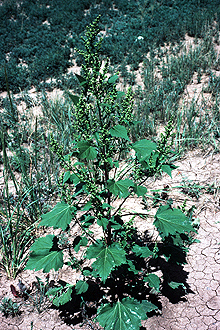User:Ljwest16/sandbox
| Ljwest16/sandbox | |
|---|---|
 | |
| Any caption you like for the picture | |
| Scientific classification | |
| Kingdom: | |
| (unranked): | |
| (unranked): | |
| Order: | |
| Family: | |
| Genus: | |
| Species: | Cyclachaena xanthifolia
|

The Giant Sumpweed,Cyclachaena Xanthifolia, is a member of the Asteraceae family. It is a nut producing angiosperm (flowering plant) that flowers annualy. The Giant Sumpweed is roughly 1-3 meters tall with stout, erect, branched stems.
Distribution
[edit]According to the USDA PLANTS dtabase Cyclachaena Xanthifolia is located in parts all around the United States and Canada. It is native all across the midwest from Michigan and Manitoba to Alberta and Mexico. It was later introduced to the Northeast, and the Pacific coast. [1]
Habitat and Ecology
[edit]"Cyclachaena Xanthifolia grows in moist areas or previously disturbed sites. [2] It can also be found in fields or along roadsides and streams. [3]
Morphology
[edit]Individuals of this species are herbacious. The leaf pattern is opposite with a possibility for alternate towards the top of the plant. The leaves are long stalked and double toothed with rough hairs on the top, and light green and fuzzy on the bottom. The flowers are in green to white in panicled spikes roughly 10' long. Some flowers are pistilate and fertile while others are perfect but sterile. The flowers bllom from August-October. [4] [5]
Interesting Facts
[edit]The Giant Sumpweed, if consumed by cows, can make the milk that is produced taste bitter. The leaves can cause dermatitis in some individuals. The pollen of this plant can cause autumn hay fever in some individuals. [6]
References
[edit]- ^ Muenscher, W. Poisonous Plants of the United States. The Maxmillan Company 1939 page 228
- ^ http://wisplants.uwsp.edu/scripts/detail.asp?SpCode=IVAXAN
- ^ Muenscher, W. Poisonous Plants of the United States. The Maxmillan Company 1939 page 228
- ^ http://wisplants.uwsp.edu/scripts/detail.asp?SpCode=IVAXAN
- ^ Muenscher, W. Poisonous Plants of the United States. The Maxmillan Company 1939 page 228
- ^ Muenscher, W. Poisonous Plants of the United States. The Maxmillan Company 1939 page 228


